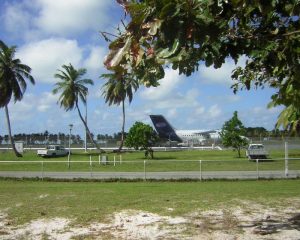Sribala Subramanian

When Senior Gen. Min Aung Hlaing visited Great Coco Island last month, his plane landed on a tarmac that was generating some buzz. Recent satellite photos showed the newly-extended airstrip had nearly doubled in length to 2,300 meters. Two new hangars and a causeway were also visible on the tiny island off the coast of Myanmar.
According to the authors of a recent report from Chatham House, the London-based think tank, the improvement was no ordinary upgrade. The hangars were wide enough to accommodate “high-performance aircraft,” perhaps surveillance planes. Great Coco, they speculated, could be turning into a naval intelligence gathering base.
Why would Myanmar, a country with a tottering economy and no external enemies, invest in a sophisticated surveillance outpost? The report suggested the military’s top brass may deploy Great Coco as a “point of future leverage,” offering up “naval intelligence acquired from surveillance flights… for desperately needed economic investment” from China. The shared reconnaissance data “would give Beijing a key regional advantage over New Delhi.”
Indian officials reportedly confronted their counterparts about the satellite images. But Myanmar denied the topic ever came up and dismissed the allegation as “absurd.” The Foreign Ministry in Beijing called the Chatham House report “sheer nonsense.”
Speculative reports on Great Coco tend to spawn conspiracy theories. In 1998, India’s defense minister alleged that the islands were on “loan” to China and that the surveillance facility would be upgraded to a “major naval base.” A few years later, India’s navy chief conceded that there was no China-installed monitoring station on the island.
Perhaps Great Coco’s upgrade should be taken at face value. Myanmar’s desire to safeguard a prized investment could be a motivating factor. In 2018, China agreed to invest $7.3 billion in a deep-water port in Rakhine State. The Kyaukphyu project would be China’s “back door” to the Indian Ocean and has been called the “most important element” of the Belt and Road Initiative in Myanmar. Construction on the port could begin soon.
Most of China’s oil imports traverse a narrow stretch of water called the Strait of Malacca, a potential “choke point” in the event of war or natural disasters. The Bay of Bengal route bypasses the bottleneck, redirecting tankers towards the Arakan coast of Myanmar. Existing pipelines at Kyaukphyu would carry the offloaded oil by pipeline to China’s Yunnan Province. In this scenario, diverted ships would head north sailing past the Coco Islands. Myanmar’s Navy could monitor the vessels from their outpost at Great Coco.
On his recent visit, Min Aung Hlaing installed a “victory post” marking Great Coco’s location as a strategic crossroads. A news report on the inauguration highlighted the significance of a shipping lane north of the Coco Islands by pointing out that “8,000 foreign going vessels pass the Preparis water course” making the region vital to “the maritime interests of Myanmar.”
And potentially important for the energy industry as well. The five Coco Islands lie within MD-3, an offshore block that MOGE (Myanma Oil and Gas Enterprise) set aside for energy exploration. The frying pan-shaped block is part of the Moattama offshore basin, a marine zone rich in hydrocarbons. MD-3 has yet to attract bids but could come up for auction soon. Myanmar’s most prolific energy producer, the Yadana gas field, lies about 100 miles north of the Coco Islands.
Min Aung Hlaing has reportedly visited the Coco Islands 19 times since 2012. “Significant changes have occurred following every single trip,” wrote a Myanmar-based defense analyst. The army chief appears focused on transforming the island into a “strategic sea fortress” even as he battles multiple insurgencies on the home front.
No comments:
Post a Comment